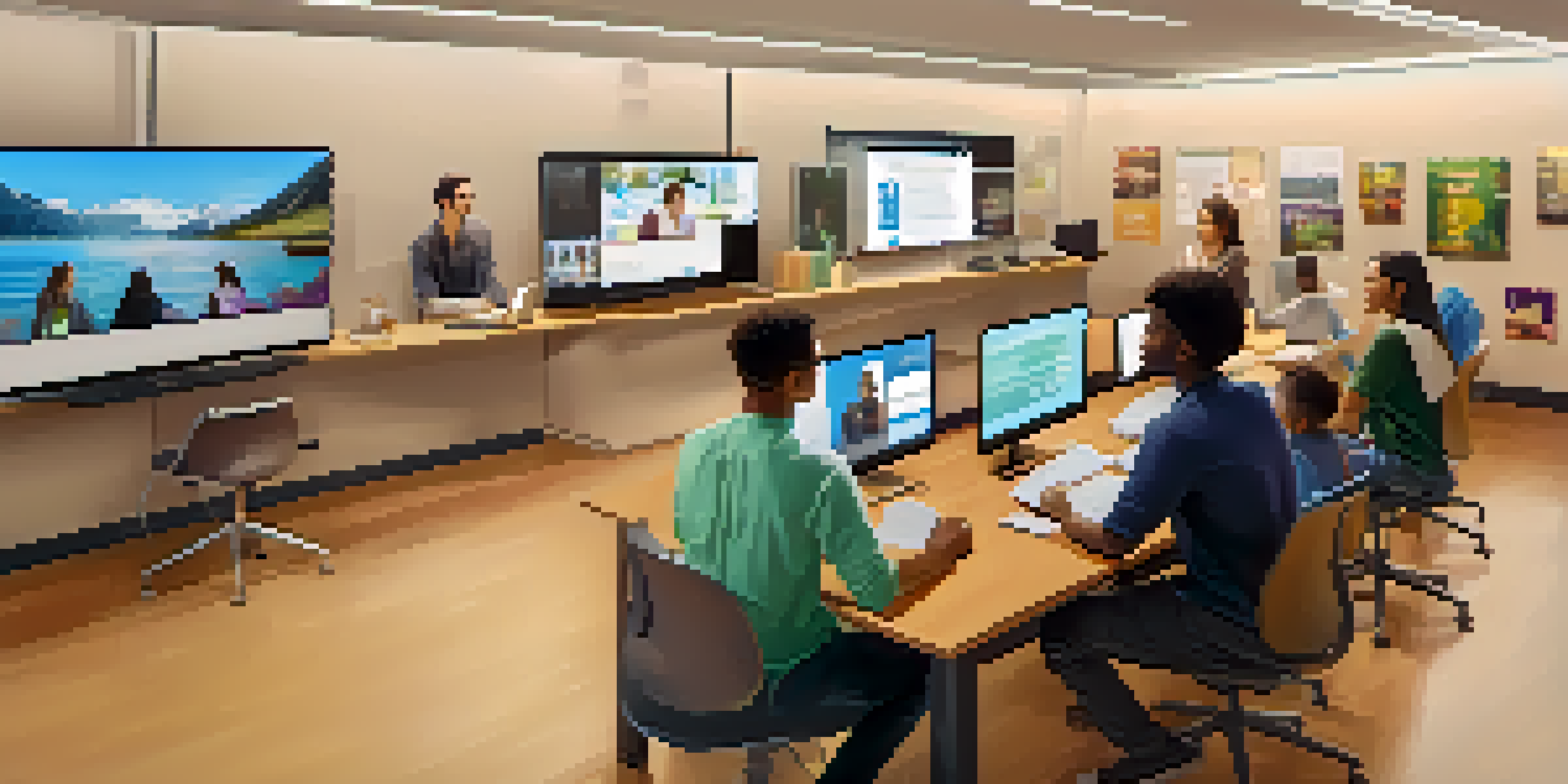Innovative Methods for Assessing Student Engagement Online

Understanding Student Engagement in Online Learning
Student engagement is at the core of successful online learning experiences. It involves not just participation but also the emotional and cognitive investment students make in their education. In a digital environment, where distractions are abundant, understanding how to measure this engagement is crucial for educators.
Engagement is not just about being present; it's about being involved and invested in the learning process.
Engagement can manifest in various ways, including attendance at live sessions, participation in discussions, and completion of assignments. Yet, it’s more than just ticking boxes; it includes the enthusiasm and interest students show in the subject matter. Recognizing these elements helps educators tailor their approaches to maximize involvement.
By identifying the different facets of engagement, we can develop innovative assessment methods that accurately reflect student involvement. This understanding paves the way for more effective strategies to keep students engaged, enhancing their overall learning experience.
Utilizing Analytics to Track Engagement Metrics
In our tech-driven world, data analytics serves as a powerful tool for assessing student engagement. Learning management systems (LMS) often provide rich data about student interactions, such as login frequency, time spent on tasks, and participation in forums. These metrics can help educators pinpoint which students may be struggling or disengaged.

For example, if a student logs in infrequently or spends minimal time on course materials, it may indicate a lack of interest or understanding. By utilizing these analytics, educators can proactively reach out to students, offering support or additional resources to rekindle their interest.
Engagement Drives Online Learning Success
Student engagement encompasses emotional and cognitive investment, crucial for enhancing online learning experiences.
Moreover, using analytics doesn’t just help in identifying disengagement; it also allows educators to refine their teaching methods. By analyzing what content engages students the most, they can adapt their courses to include more of what resonates with learners, creating a more engaging environment overall.
Interactive Quizzes as Engagement Tools
Quizzes have long been a staple in education, but when designed interactively, they can significantly boost student engagement. Online platforms allow for the creation of quizzes that not only assess knowledge but also encourage participation through gamification elements. Points, leaderboards, and immediate feedback can make learning feel like a fun challenge.
The best way to predict the future is to create it.
For instance, using platforms like Kahoot! or Quizizz, educators can transform a standard quiz into a lively competition. This dynamic format not only motivates students but also fosters a sense of community as they engage with their peers in real-time.
Furthermore, interactive quizzes provide immediate insights into student understanding. Educators can quickly identify areas where students struggle, allowing them to adjust their teaching strategies on the fly to better meet learners' needs.
Encouraging Collaborative Projects for Deeper Engagement
Collaborative projects can serve as a powerful method for enhancing student engagement in online settings. By working together, students not only learn from each other but also develop essential skills such as communication and teamwork. This sense of collaboration can make online learning feel more connected and less isolating.
Consider assigning group projects where students must create a presentation or report on a topic. This approach requires them to engage deeply with the material and each other, leading to richer learning experiences. Furthermore, collaboration fosters accountability; students are less likely to disengage when their peers depend on them.
Analytics Identify Engagement Levels
Utilizing data analytics from learning management systems helps educators track student interactions and identify those who may be disengaged.
To facilitate this, educators can utilize tools like Google Workspace or Microsoft Teams, which allow for seamless collaboration and communication. By leveraging these platforms, students can share ideas, give feedback, and ultimately feel more invested in their learning journey.
Incorporating Multimedia to Enhance Engagement
Multimedia elements, such as videos, podcasts, and infographics, can significantly enhance student engagement in online courses. By breaking up text-heavy content with dynamic visuals or audio, educators can cater to various learning styles and keep learners interested. This variety helps maintain attention and reinforces the material being taught.
For example, a lecture that includes a short video clip can illustrate complex concepts more effectively than words alone. It provides context and sparks discussions among students, inviting them to share their thoughts and interpretations. This interaction not only deepens understanding but also fosters a sense of community.
Additionally, incorporating multimedia encourages students to create their own content. By assigning projects that allow them to produce videos or podcasts, they become active participants in their learning, which can further enhance their engagement with the subject matter.
Feedback Mechanisms: A Two-Way Street for Engagement
Feedback mechanisms are essential for fostering engagement and ensuring that students feel heard. In an online environment, it’s vital to establish channels through which students can express their thoughts and feelings about the course. This two-way communication not only helps educators gauge engagement but also empowers students to take ownership of their learning.
Regular feedback surveys or check-ins can provide valuable insights into how students perceive the course materials and their engagement levels. For example, a brief survey after a module can highlight what worked well and what needs improvement. This feedback can guide educators in adjusting their content and teaching methods.
Collaborative Projects Enhance Learning
Encouraging collaborative projects fosters deeper engagement by promoting communication and accountability among students.
Moreover, when students see that their feedback is valued and acted upon, they are more likely to remain engaged. It creates a sense of community and partnership in the learning process, reinforcing their commitment to the course.
Innovative Technologies: Virtual Reality and Beyond
Emerging technologies like virtual reality (VR) and augmented reality (AR) are revolutionizing the way we assess and enhance student engagement. These technologies create immersive learning experiences, allowing students to explore subjects in a hands-on way that traditional methods cannot replicate. For instance, a VR experience can transport students to historical events or scientific phenomena, making learning exciting and tangible.
Incorporating VR into online courses can significantly boost engagement levels, as students are able to interact with the content in a more meaningful way. This level of interactivity not only captures their attention but also fosters a deeper understanding of complex concepts.

While these technologies may seem futuristic, they are becoming increasingly accessible. As educators explore innovative solutions, integrating VR and AR can inspire students and create enriched learning environments that keep them engaged and excited about their education.